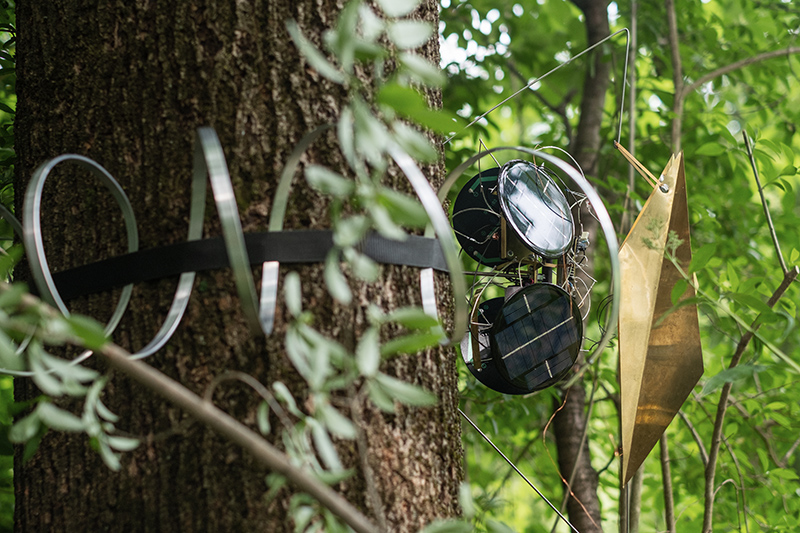What if culture was actually nature? Can technology and botany be connected? In SONAR PARK /entanglements 2021, we addressed these questions from the perspective of Electronic Arts and New Musics.
Our utopia left behind anthropomorphic forms, seeking sound experiences that connect with biological systems and the non-human. SONAR PARK 2021 showed how organic processes drive electric circuits (Ioana Vreme Moser: Arboreal Receptors) and made vegetal biorhythm audible (Data Garden, PlantWave). It presented the possible sonic interweaving of humans and insects (Saša Spačal, Transversal is a Loop) and brought the disruptive poesy of the early avant-gardes back to its origins in bird song (Astrid Seme, Urbirds Singing the Sonata).
Artists: Joe Patitucci aka Data Garden (USA), Astrid Seme (AT), Saša Spačal (SL) and Ioana Vreme Moser (RO/D).
Curator: Lona Gaikis.
Academic publication: Lona Gaikis. Thinking with Susanne Langer: Sonar Entanglements with the Nonhuman. Open Philosophy 4, no. 1 (DeGruyter, 2021): 149–61. Download PDF here.
12. June – 3. July 2021. Sonnenpark LAMES, St. Pölten, Austria.
Ioana Vreme Moser: Arboreal Receptors
Site-specific sound installation. Toroidal coupling coil, crystal diodes, solar panel, power amplifier, motor, antenna.
Arboreal Receptors shows the occurrence of aerial radio-electromagnetic fields from a tree’s perspective. As sculptural instruments, Ioana Vreme Moser created self-perpetuating kinetic devices on tree trunks, which resonate the invisible currents that intersect in two very different networks. Above the ground—in the air—we find a multitude of human-made radio-electromagnetic fields. They inconspicuously expand as a large network in both urban and natural landscapes. Underground, lies an entangling of roots that constitute quite a different kind of network—one that strongly depends on cohabitation and mutuality. Mycorrhizal fungal systems—affectionately called the ‘Wood Wide Web’—nurture trees, but get disturbed by electromagnetic eruptions that are picked up and perpetuated by the trees. Our Wi-Fi and mobile networks continuously interfere with this intricate underground ecosystem.
Inspired by early engineering experiments with tree radio reception (George O’Squier 1904), Arboreal Receptors converts the tree into an antenna and intercepts those moments where the two networks (electric and living) collide. When activated in an arboreal collective, the instruments move in irregular patterns and unveil the clashing of natural and artificial informational systems.
Astrid Seme: Urbirds Singing the Sonata (2010)
Outdoor multichannel sound installation, 33 min.
Urbirds Singing the Sonata (2010) brings Kurt Schwitters’ sound poem The Ursonata (1932) home to the myth that birds had played a major role in the creation of the piece. In collaboration with an ornithologist, Astrid translated The Ursonata into a score for birds, thereby showing what Schwitters’ poem might sound like to our feathered friends. The outdoor sound installation brings Schwitters’ seminal avant-garde piece back to its origin in nature.
Astrid Seme’s visual and sound works deconstruct peripheral elements of language into movement, sound and hypothetical generic forms. She seeks to reveal the oft-unseen phenomena that resonate in our daily communication. Her speculative-analytical look behind the scenes of language humorously articulates the latent ambiguity of interpersonal communication.
There has never been complete consensus on what the key influences on Kurt Schwitters were when he was preparing his sound poem Ursonate (1922–1932). One myth claims he was inspired by bird sounds. I strongly believe this to be true and wanted to bring the birds back their primordial song—their Ursonate. Urbirds singing the Sonata narrates and describes what Kurt Schwitters might have heard when he wrote his poem. —Astrid Seme.
Saša Spačal: Transversal is a Loop (2019-ongoing)
Sonic interspecies meditation, 50 min.

Transversal is a Loop is a series of sonic entanglements between sound artist Saša Spačal and the cricket species acheta domesticus. As a transversal sonic line that intersects three planes of cricket existence, this performance sonically explores the dynamic equilibrium of their terrestrial habitats, their vulnerability to extinction, and modes of survival.
The piece articulates as a fifty-minute sound meditation, in which the artist and the crickets delve into ways of how to ‘think’ and ‘act’ music jointly. Transversal is a Loop lends a voice to how crickets live and interact in their environment. Technologically equips them to become co-creators of a unique musical matrix.
Outdoors at SONAR PARK, the hybrid soundscape embeds in the dynamic sounds of the natural environment, immersing us in the forms and sonic patterns of these mystical and sonically-symbiotic companions.
Data Garden: PlantWave (2021)
Device to sonify vegetable biorhythm, iOS App.
PlantWave lets you listen to music played by your plants. The device detects slight electrical variations in a plant via two electrodes placed on the leaves. These variations are graphed as a wave, which is translated into pitch messages that play musical instruments designed by a team of sound artists. Other characteristics of the wave are used to modify the timbral qualities of the instruments. The result is a continuous stream of ambient music that gives the listener a sonic window into the secret life of plants.
PlantWave can be connected to a plant and paired with a phone or pro music equipment like MIDI synths and Digital Audio Workstations via USB, WiFi or 3.5mm TRS Type A MIDI.
This technology is based on plant biologist and engineer Cleve Backster’s 1960s research on human-plant communication. He found that plants react sensitively to the presence and actions of humans, and utilized polygraphs (lie detectors) to record the changes in the electrical resistance within them.
Download PDF booklet: HERE.
This project was realized by IMA Institute of Media Archaeology and Sonnenpark LAMES, St. Pölten (AT), and was funded by BMKÖS, the Cultural Fund of Lower Austria and the City Council of St. Pölten.



